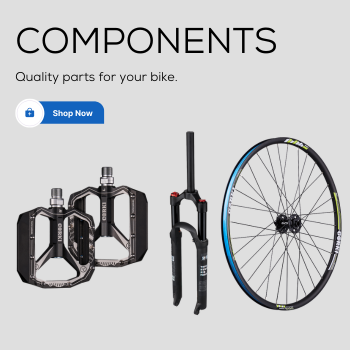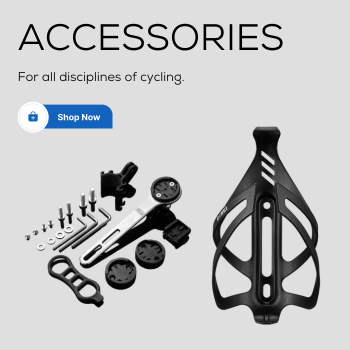
Greetings, riders! Ever dreamt of a bike that's an extension of you? Join us on a journey to customize every aspect of your ride, from the frame beneath you to the handlebars guiding you. Let's craft a ride that's uniquely yours!
Understanding your Bike Needs

Identify Your Biking Style
When customizing your bike, it's important to know how you like to ride. Do you prefer speed and city streets, off-road adventures, or a relaxed cruise? Knowing your style will help you choose the right components to improve your riding experience. Start by identifying your biking style, then select the components that match your preferences. This will create a strong foundation for enhancing your overall ride.
Determine the Terrain
Where you ride matters, and different terrains demand different bike features. If you love exploring rugged trails, your bike needs sturdy components built for off-road adventures. On the flip side, if you stick to smooth city streets, a lighter and more streamlined setup might be your go-to. Determining the terrain you'll most frequently encounter guides your customization choices for optimal performance and enjoyment.
The Level of Comfort Needed
Comfort is the secret ingredient for a satisfying ride. Think about the level of comfort you need during your cycling adventures. Does your back ache after a long ride? Are your hands uncomfortable on the handlebars? Considering these factors helps you pinpoint areas that can be customized for a cozier experience. From choosing the right saddle to adjusting the handlebar height, tailoring your bike's comfort level ensures that every ride is a joy, not a pain.
Components of a Bike You Can Customize

Frame
When it comes to creating your ideal bicycle, the frame acts as the foundation on which you build your perfect ride. Let's delve into the essentials – the types of frames, the materials that shape them, and the art of finding the perfect size for an optimal fit.
Frames Types
Bike frames come in distinct types tailored to different riding preferences:
- Road Frames: If speed and efficiency on smooth roads are your goals, road frames are your go-to. They're designed for aerodynamics and a forward-leaning position, perfect for those long stretches of pavement.
- Mountain Frames: For off-road enthusiasts, mountain frames offer a sturdy build to tackle rugged terrains. These frames are built to withstand the bumps, jumps, and twists of trail riding.
- Hybrid Frames: Combining features from both road and mountain frames, hybrids are versatile options suitable for city commuting and light trail use. They offer a comfortable upright riding position.
Materials
The material of your frame plays a crucial role in its weight, durability, and overall performance:
- Aluminum: Known for its lightweightness and affordability, aluminum frames are popular among budget-conscious riders. They offer a good balance of strength and cost-effectiveness.
- Carbon Fiber: At the higher end of the spectrum, carbon fiber frames provide an excellent strength-to-weight ratio. They are favored for their stiffness, reducing vibration, and offering a smooth ride.
- Steel: If durability is a top priority, steel frames are a solid choice. They may be heavier than aluminum or carbon fiber but offer a smooth and comfortable ride, absorbing road vibrations effectively.
Size and Fitting
Selecting the right frame size is akin to finding the perfect pair of shoes – it ensures comfort and optimal performance:
- Standover Height: This is the distance between the top tube of the frame and the ground. A suitable standover height prevents discomfort during dismounts.
- Top Tube Length: The length of the top tube affects your reach on the bike. A proper fit ensures a comfortable riding posture and efficient pedaling.
- Stack and Reach: These measurements define the frame's geometry and play a crucial role in your riding position. The stack refers to the height, and the reach refers to the horizontal length, influencing how you sit on the bike.
Wheels
Your bike's wheels are essential for a smooth and efficient ride on different terrains. Now, there are two main types: MTB (Mountain Bike) wheels and road bike wheels.
MTB Wheels
MTB wheels are essential for those who love off-roading and exploring new trails. They play a vital role in ensuring a smooth and safe ride. These wheels are engineered for durability, traction, and maneuverability over challenging terrains. They come in different sizes, with 26-inch, 27.5-inch, and 29-inch being the common standards. The larger the wheel, the better it rolls over obstacles, providing stability on rocky paths and enhancing overall control. Tubeless MTB tires have gained popularity, offering reduced risk of flats and improved grip, ensuring a more confident ride through the twists and turns of the trail.
Road Bike Wheels
Now, if you're into cruising fast on smooth roads, road bike wheels are your pals. They're a bit bigger, usually 700c size. These wheels are all about slicing through the air to make you go faster. The rims (the outer part of the wheel) come in different shapes – some are deep for extra speed, and some are light for quick moves. And the tires are skinny, making you zoom on the pavement.
You can find a comprehensive guide on Road Bike Wheelsets: A Comprehensive Guide to Choosing the Right Ones.
Drivetrain
The drivetrain is a crucial part of your bike that makes it move. It's part of a groupset, which includes shifters and brakes, all working together to control your ride. The drivetrain's main job is dealing with gears. It usually has one or two derailleurs that shift gears when you use the shifter.
The chain is also a big player here, moving over the cassette and crankset, where your gears are. When you pedal, all these parts work together, turning your effort into movement. Not all bikes have gears – some keep it simple with just one speed, and others use different systems like belt drives.
When it comes to taking care of your bike, it's important to pay attention to the chain and drivetrain components. You can learn more about how to maintain and upgrade these parts by checking out the article titled "The Importance of Bike Chain and Drivetrain Components: Maintenance and Upgrades."
Brakes
There are three main types of brakes that you can choose from for your dream bike: disc brakes, caliper rim brakes, and V-brakes. The most popular choice nowadays, especially for road bikes, is hydraulic disc brakes, which have been successful on mountain bikes as well. These brakes offer precise control and strong stopping power.
However, caliper rim brakes and V-brakes are more commonly found on affordable bikes. While disc brakes are becoming increasingly popular, some high-end road teams outside of the World Tour still prefer rim brakes for racing. Therefore, when customizing your dream ride, your choice of brakes will depend on your budget, preferences, and the type of cycling you plan to do.
You can upgrade your bike's stopping power by improving its braking system. Read this article to learn more.
Handlebars
Let's turn our attention to a critical component that greatly influences your riding experience – the handlebars. The type of handlebars you choose can impact not only your comfort but also your control and maneuverability. Here's a breakdown of some common types to help you find the perfect fit for your personalized ride.

- Drop Bars: Commonly found on road bikes, drop bars are characterized by their aerodynamic shape. They offer multiple hand positions, promoting speed and efficiency. The lower-hand positions are ideal for tucking in during a brisk ride.
- Flat Bars: Popular on mountain bikes, hybrid bikes, and city bikes, flat bars provide a more upright riding position. They offer simplicity and a wide, open grip, allowing for better control, especially on uneven terrains. Flat bars are a go-to for riders who prioritize visibility and maneuverability.
- Riser Bars: Often seen on mountain bikes, riser bars rise above the stem at varying angles. They provide a more upright riding position compared to flat bars, enhancing control and visibility on technical trails. Riser bars are favored by off-road enthusiasts for their comfortable stance.
- Bullhorn Bars: Bullhorn bars have a unique appearance, resembling the horns of a bull. These bars extend outward, providing a variety of hand positions and a clean, minimalist look. Popular among urban cyclists and fixie enthusiasts, bullhorns offer a balance of comfort and control, allowing for a more aggressive riding posture when needed.
Selecting the right handlebar type depends on your riding style, preferences, and the kind of terrain you frequent. Whether you're chasing speed on the road or navigating tricky trails, choosing the appropriate handlebar can significantly enhance your riding experience.
Conclusion
As we wrap up our dive into bike customization, remember – every choice shapes your dream ride. From frame to handlebars, your bike becomes a reflection of you. Now, let the wheels of your inspiration turn into action. Start your custom bike project and pedal into your personalized adventure.




